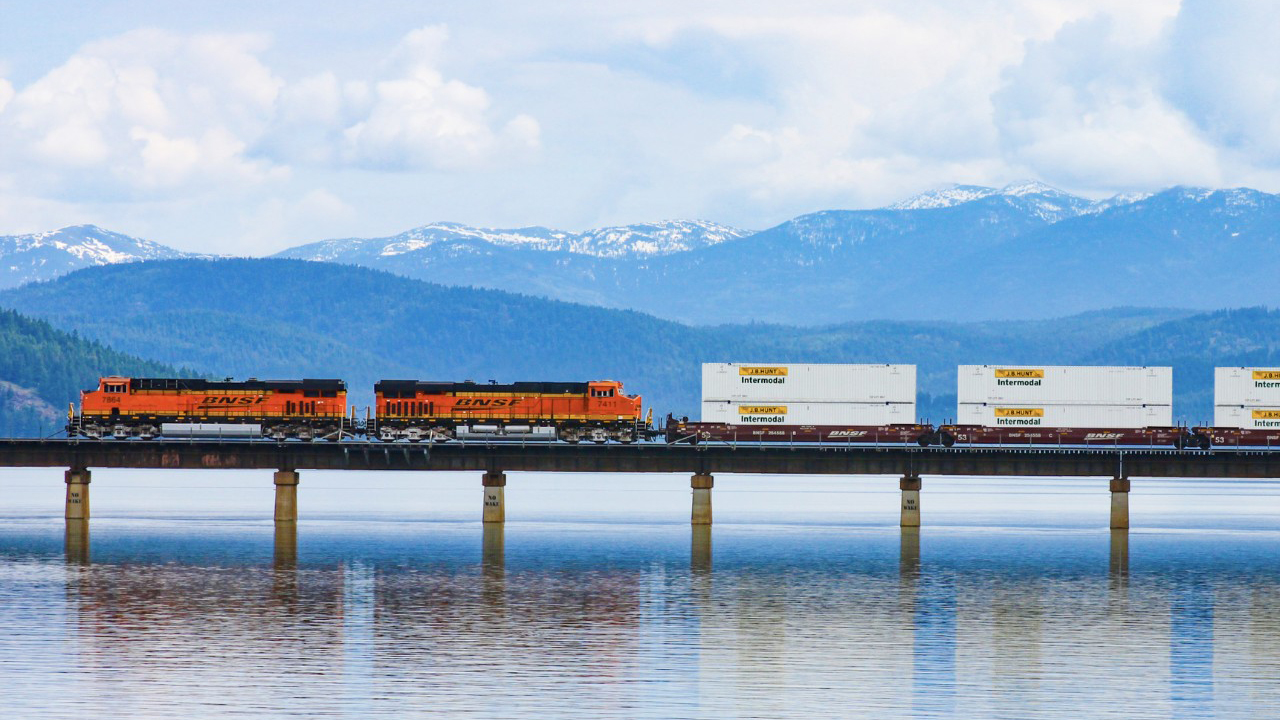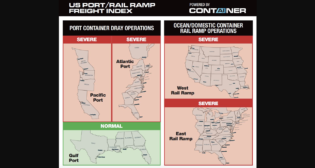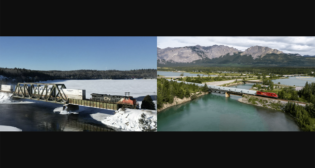
Reason Together or Face the Sword
Written by Frank N. Wilner, Capitol Hill Contributing Editor
J.B. Hunt photo
WATCHING WASHINGTON, RAILWAY AGE SEPTEMBER 2022 ISSUE: As Atchison, Topeka & Santa Fe Railway (Santa Fe, now part of BNSF) intermodal train No. 198 sprinted from Chicago toward Kansas City one November day in 1989, a special guest was aboard an attached business car.
Hosting Johnny Bryan (J.B.) Hunt, founder of what had become America’s third largest trucking company, was then-Santa Fe President Michael R. Haverty (later CEO of Kansas City Southern and now retired).
As Haverty, who earned entry with other railroad visionaries—including Alfred E. Perlman, Louis W. Menk, John W. Barriger III, D. William Brosnan and W. Graham Claytor Jr.—into the National Railroad Hall of Fame, recalls, “J.B. was transfixed by other intermodal trains passing in the opposite direction.” As parallel-to-rail highways came into view, Hunt took equal measure of the procession of 18-wheelers, each requiring one driver.
A fourth-generation railroader who worked as a switchman and brakeman before earning an MBA and moving up the management ranks, Haverty interspersed his sales pitch with explanations of rail operating practices and how UPS—idolized by Hunt for its operating efficiency and service reliability—had become Santa Fe’s biggest intermodal customer.
Within days, Railway Age’s 2001 Railroader of the Year had convinced Hunt to ink a contract creating a dedicated, premium-priced intermodal service on Santa Fe named Quantum, growing to some 600,000 loads annually by 2005.
Were today’s rail CEOs to shift from reading stock quotations at 30,000 feet to inviting their labor union leaders to join them in inspecting the railroad at human-eye level, disturbing scenes would appear quite different than what energized Hunt to shift his trailers from road to rail.
On rail-parallel highways between Dallas and Atlanta, for example, rail labor chiefs might see semi-autonomous trucks operating, whose artificial intelligence is learning—and with federal subsidies, no less—to navigate federally constructed and state maintained Interstate highways without drivers.
Evolving technology embraced by truckers threatens to reverse Haverty’s intermodal vision and visit on railroads and those dependent on them—including employees and their families—destructive long-term consequences.
In the Dallas-Atlanta demonstration project, one driver monitors a lead tractor-trailer with a second 30 feet behind controlled autonomously—a second driver aboard only to operate the rig the first and last mile and otherwise rest to comply with hours-of-service regulations before switching places with the lead rig. The result is near round-the-clock equipment utilization. Should both drivers be eliminated, and battery-operated tractors substituted, truck operating costs will be slashed 30%. Grey heads may balk at driverless technology, but not so impatient younger whiz bangs designing it.
The competitive challenge for rail is to match these cost reductions, as trucking’s greater service capabilities require rail intermodal pricing to be below that of motor carrier rivals.
With the collapse of bedrock coal traffic, intermodal now keeps rail earnings buoyant, but that market similarly will evaporate if railroads are blocked from squeezing more productivity out of their own technological advancements such as Positive Train Control (PTC), which allows for redeployment of on-board conductors to more productive ground-based positions.
Productivity advances of rail rivals are making labor’s inflexible opposition to conductor redeployment toxic to future rail profitability—the golden goose funding job security and wage growth.
Labor-management collaboration is essential to determine the most productive use of train crews, rewriting of safety rules and contractual improvements in conductor and engineer lifestyles—enrichments that include more predictable work schedules, fewer off-hours away from home and furlough protection. That collaboration is necessary at the national level if seamless train operation over an interconnected and highly interdependent rail network is to be preserved.
With acknowledgment that rival trucking, not management, is the enemy of rail labor, collaboration can extend to joint design of next generation train control, and adjustments to Precision Scheduled Railroading (PSR) to correct its negative aspects while preserving PSR’s ability to improve asset utilization and deliver service reliability at lowest operating cost.
Failure to reason together in assuring more intelligent productivity enhancements as offered by PTC and PSR only ensures both rail labor and carriers will be devoured by the sword of greater motor carrier flexibility and its embrace of technological advancements.

Capitol Hill Contributing Editor Frank N. Wilner is author of six books, among them Amtrak: Past, Present, Future; Understanding the Railway Labor Act; and Railroad Mergers: History, Analysis, Insight, all published by Simmons-Boardman Books. Publication of his seventh book, “Railroads & Economic Regulation,” is pending by Simmons-Boardman Books. Wilner earned undergraduate and graduate degrees in economics and labor relations from Virginia Tech. He has been Assistant Vice President, Policy at the Association of American Railroads; a White House appointed chief of staff at the Surface Transportation Board; and director of public relations for the United Transportation Union. He is a past president of the Association of Transportation Law Professionals. Wilner drafted the railroad section of the Heritage Foundation’s Mandate for Leadership (Volumes I and II), which were policy blueprints for the two Reagan Administrations; and was a guest columnist for the Cato Institute’s Regulation magazine.



